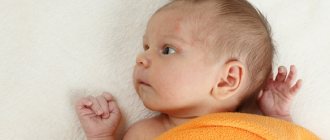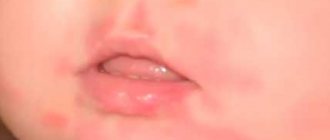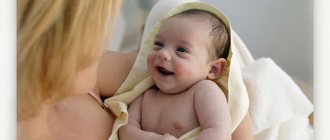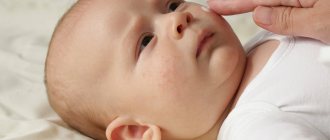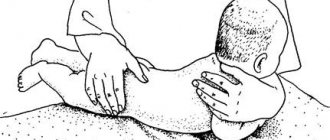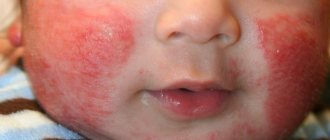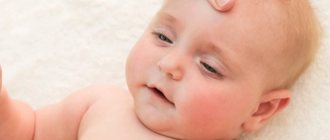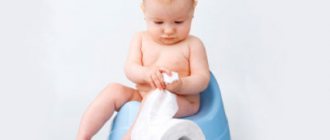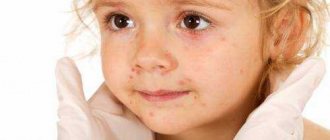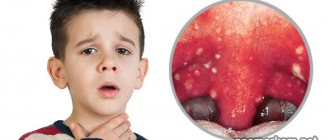The main causes of acne and acne in newborns
Scientifically, acne of newborns is neonatal cephalic pustulosis. This is how this disease is treated in medicine. The rash itself looks like teenage acne. These are white clumps under the top layer of skin. Such whiteheads, similar to red dots, can be on the surface of any part of the child: the body, nose, forehead, cheeks, head or back.
Some parents mistakenly associate the appearance of various types of rashes on the face of infants with non-compliance with hygiene rules. In fact, this is a fallacy. Whiteheads and blackheads have nothing to do with improper care.
The main causes of acne in newborns are:
- Maternal hormones that enter the baby's blood during childbirth or breastfeeding.
- Improper functioning of the sebaceous glands. In newborns, the sebum production system has not yet been established; the sebaceous glands work at an accelerated pace, secreting a lot of sebum. This leads to clogged pores and whiteheads on the face.
- Changes in the functioning of the hormonal system of the baby.
- Adaptation of the child's skin to the external polluted environment.
Most often, a rash in newborns appears in the first weeks of life and worries up to a maximum of 2-3 months. This is quite common, and about 30% of all newborns are susceptible to such skin problems. In any case, mom shouldn’t worry, these white bumps will disappear without leaving a trace, and no spots or black spots will remain.
Such rashes and acne are not contagious; they have nothing to do with bacteria, germs and infections.
Acne in babies is either closed or open comedones. But what distinguishes them from adult comedones is that they go away on their own, without requiring the use of special ointments and creams. While blackheads in teenagers will appear even stronger if you do not follow the rules of careful care.
Are black dots on a baby’s face a physiological norm or a disease?
So HE came into your life.
The one you have been waiting for so long, about whom you have dreamed. Now he is here, separate from you. You feel tenderness just thinking about him next to you. About your baby. Thinking about her child, every mother imagines small heels, a fragrant crown and delicate skin.
The black dots on the baby's face do not fit into this idealistic picture at all. Although according to statistics, approximately 20-30% of children develop this scourge in the first months of life.
Pediatricians call hormonal changes the main reason for the appearance of black and white dots on the face of infants.
After a child is born, his body begins to work in a new way in the conditions of the outside world.
During the late stages of pregnancy, he receives estrogens, that is, female sex hormones, in large quantities from his mother.
They become the main factors of the crisis that the baby’s endocrine system is experiencing.
This malfunction is expressed in the fact that the secretion located in the ducts of the sebaceous glands thickens, and the narrowest of them become clogged, forming milia on the face of newborns. But milia are white pimples, and the main places where they appear are the forehead, the nose and folds around it, the chin, and sometimes the back of the head and neck of the child.
White pimples are absolutely safe for the baby's health. They go away on their own.
The main thing to remember: there is no need to touch them. At the latest, by three to four months, not a trace will remain of these white bubbles.
A hormonal crisis in infants in the first weeks of life can be accompanied by engorgement of the mammary glands, both in girls and boys. The external genitalia may also swell. These manifestations should not frighten parents - most often, within one week of the baby’s life, the hormonal balance is restored and everything returns to normal.
Reason for turning into blackheads
Black dots are milia transformed for various reasons.
They are called comedones and are located in the same place as the white rashes.
If a light vesicle, that is, a sebaceous gland, opens and dirt gets in, inflammation may begin.
If parents do not observe a red rim around such formations or swelling, then there is no need to worry: the comedones will soon disappear, leaving no marks on the baby’s face.
Inflamed dark lesions require the correct approach to daily hygiene, careful observation, and usually resolve over time.
If inflammation is observed around the black grains - redness or swelling of the skin, the baby should be shown to a pediatrician, and further treatment should be carried out under the supervision of a doctor.
What should parents do?
- It is useful to carry out air baths for a child. They relate to hardening procedures, so when using them it is important to follow the following rules - the first air baths must be organized at an air temperature of at least 22-24 ° C and carried out for no longer than 1-2 minutes. Such procedures can be carried out 3 times a day, combining them with massage, gymnastics and swaddling. Over time, the duration of exposure to air can be increased to 4-5 minutes, gradually reducing the air temperature to 18-20 ° C.
- Hygiene and care for the little man should be daily and regular. The child should be washed with boiled water 2 times a day, using lumps of sterile cotton wool. It is extremely important for older family members to maintain personal hygiene - wash their hands more often, especially in summer.
- Sunbathing is necessary for growth and development. But the child needs to be accustomed to sunlight gradually, avoiding exposure of the skin to tiny amounts of direct sunlight. At first, the duration of sunbathing should not exceed 2 minutes. At the first sessions, it is allowed to leave only the baby’s legs open, then the tummy and a little later the chest. Gradually, exposure to the sun can be increased to 15-20 minutes. When it is clear that the child is ready for complete nudity and his skin is accustomed to the sun's rays, it is not forbidden to undress him completely. But this only applies to the body; the baby’s head is always covered with a cap, scarf or any other headdress. Remember that active sunbathing is contraindicated for babies in their first year of life.
When walking with your baby, it is advisable to choose a time either in the morning or in the late afternoon, when the sun is less active. It is useful to take light-air baths, moving with your child in the shade of trees or under a summer umbrella.
- Be sure to trim your baby’s nails so that he doesn’t scratch himself or introduce an infection into the wound. His manicure set, like an adult’s, will be individual. The process of cutting the nails of a small family member, on the one hand, is extremely simple - who hasn’t cut their own nails, on the other hand, it is also extremely complicated - the fingers are so small that it’s scary to pick them up. It is most effective to start the procedure after bathing, when the skin and nails have steamed and become soft. Before water procedures, you need to prepare: wipe the scissors and nippers with medical alcohol. On the feet, it is important to cut the nails in a straight line so that they do not grow into the skin, and on the hands, round them. You should not cut the nail plate very short - this can cause pain to the baby and provoke an inflammatory process.
- It is useful to ventilate the room in which the baby is located as often as possible, to ensure that the temperature and humidity in the room are maintained at an optimal level. The most comfortable temperature is from twenty to twenty-two degrees, humidity is 70 percent.
- It is important not to make a mistake when choosing products for washing children's clothes and bedding. Preference should be given to hypoallergenic formulations containing natural ingredients.
What is not recommended to do if blackheads are detected?
- Under no circumstances should you open or try to squeeze out comedones . Such actions can lead to infection of the sebaceous gland duct and its inflammation. The baby's delicate skin can be seriously damaged, and scars will remain on it in the future.
- Do not use aggressive disinfectants containing alcohol . This causes dry skin, which increases the risk of microtrauma and infection. The same rule applies to talc and powder, which also dry out the skin.
- It is not advisable to apply any cream to a child’s face (except when the product is prescribed by a doctor). Fatty creams are especially harmful: they further clog the sebaceous glands, aggravating the situation.
- Pay close attention to how the child is dressed and try not to wrap him up . Children who are bundled up are more likely to develop heat rash and other dermatological problems. It’s easy to check if your baby is dressed correctly. If a child has a wet neck and back of the head, then he is most likely hot, and some clothes need to be removed or replaced with lighter ones.
- Pink and swollen skin around blackheads indicates that there is an infection inside the duct. Sometimes acne turns into small pustules, which should not be opened under any circumstances, because there is a risk of infection.
- You can wipe the spots where the spots appear with a decoction of string or chamomile infusion. A decoction of the string can be prepared according to the following recipe. 15 g of string is poured into an enamel or porcelain bowl with two glasses of boiling water, and the dishes are placed in a water bath. The main thing is to remember to cover it with a lid. Boiling lasts no more than 15 minutes, after which the broth cools for 40 minutes. To prepare chamomile infusion, you need to take a tablespoon of chopped dried herbs and pour a liter of boiling water. Then leave to infuse for a couple of hours (it is better to use a thermos for this).
- Salicylic acid diluted with water works well.
- If the pimple has opened, it can be cauterized with fucorcin or brilliant green. Solutions are applied pointwise to areas of damaged skin with a cotton swab, cosmetic disc or cotton swab. Damage is treated 2-4 times a day.
It is always necessary to keep in mind that timely consultation with a doctor can prevent such serious consequences of acne as furunculosis, treptoderma or pyoderma.
Contact a specialist in a timely manner, and he will select a treatment program based on your specific case and effective specifically for your baby.
Young parents are faced with a difficult task. You have to go through the thorny path of ignorance and inexperience, other people's advice and answers from smart books, and develop your own strategy for behavior with the child. And the most important goal is to learn to remain calm!
Source: https://momjournal.ru/zdorove-rebenka/detskie-bolezni/chernye-tochki-na-lice-u-grudnichka.html
Treatment of acne in children
loading…
Acne and acne in infants go away on their own, so you should not try to speed up this process by using medications. Within a month or two, your child’s skin will clear up and you won’t even remember that there were problems. Special treatment in such cases is not prescribed. The only exception can be a condition when the number of pimples increases every day, they progress and do not go away within 3 months. In this case, the pediatrician may prescribe medications. But you should absolutely not self-medicate, it is very dangerous for the child! He may be left with spots or blackheads on his face.
In order to help your baby better cope with such a skin disease, you should adhere to the following rules:
- Treat the skin surface with a special softening cream (Bepanten or Panthenol) and zinc ointment. But not regularly, but only every 3-4 days.
- Wash your skin frequently with baby cleansers to keep it clean.
- Make sure that the room is not stuffy and ventilate the room regularly.
Absolutely forbidden:
- Squeeze any inflammation on the child’s face or body. You can make the situation worse by introducing bacteria and contaminants into the wounds. After squeezing, spots resembling black dots may also remain.
- Apply antiseptic preparations to small rashes (pimples, acne, blackheads): brilliant green, fucorcin, potassium permanganate solution. No such treatment is required!
At home, herbal decoctions are often used to help improve the condition of the baby's skin. It can be a succession or chamomile herb.
Remember, the key to dealing with newborn acne is patience. Wait a few weeks or months and the skin problems will go away on their own. There is no need to treat them.
Return to contents
Prevention - useful tips for parents
Basic rules of hygiene, to which the child must be taught from childhood, will help prevent the appearance of black dots on a child’s nose. Washing your face daily with soap (preferably using an antibacterial agent) will help reduce the activity of the sebaceous glands and prevent clogging of pores or inflammatory processes.
For a child whose skin is prone to the appearance of an oily film, you can purchase a special baby lotion that will normalize the condition of the skin. It is strictly forbidden to use preparations for adults containing alcohol - this can lead to increased dryness and flaking.
It is under no circumstances recommended to try to get rid of formations on a child’s nose mechanically. Squeezing out blackheads threatens not only the development of inflammatory processes, but also the introduction of infection, which can result in serious problems with children's sensitive skin.
How to distinguish acne from allergies?
Parents often confuse acne with an allergy rash. This is not surprising, because such rashes have a lot in common. But you should know the characteristics of acne and allergy rashes in order to be able to distinguish them. This is important because allergies, unlike acne, require treatment and the use of special products.
Let's look at their main differences:
- First of all, the two types of these rashes differ in appearance. So, an allergy rash is red without purulent tubercles. Most often it is small. And acne in newborns has a white purulent top and a red base.
- Another distinctive feature is that an allergy rash causes a lot of inconvenience to the child, itching appears, and the area of the rash itches. There is even vomiting and poor sleep. And with acne and acne, there is no discomfort, and the baby behaves calmly.
- Location is a sign that also allows you to distinguish types of rashes from each other. Acne appears mainly on the face, cheeks, chin or nose. And allergies are characterized by the appearance of red spots on almost any area: on the body, head, buttocks or butt.
Return to contents
Actions in case of inflammation
- Pink and swollen skin around blackheads indicates that there is an infection inside the duct. Sometimes acne turns into small pustules, which should not be opened under any circumstances, because there is a risk of infection.
- You can wipe the spots where the spots appear with a decoction of string or chamomile infusion. A decoction of the string can be prepared according to the following recipe. 15 g of string is poured into an enamel or porcelain bowl with two glasses of boiling water, and the dishes are placed in a water bath. The main thing is to remember to cover it with a lid. Boiling lasts no more than 15 minutes, after which the broth cools for 40 minutes. To prepare chamomile infusion, you need to take a tablespoon of chopped dried herbs and pour a liter of boiling water. Then leave to infuse for a couple of hours (it is better to use a thermos for this).
- Salicylic acid diluted with water works well.
- If the pimple has opened, it can be cauterized with fucorcin or brilliant green. Solutions are applied pointwise to areas of damaged skin with a cotton swab, cosmetic disc or cotton swab. Damage is treated 2-4 times a day.
It is always necessary to keep in mind that timely consultation with a doctor can prevent such serious consequences of acne as furunculosis, treptoderma or pyoderma.
Young parents are faced with a difficult task. You have to go through the thorny path of ignorance and inexperience, other people's advice and answers from smart books, and develop your own strategy for behavior with the child. And the most important goal is to learn to remain calm!
News MirTesen
Millet in newborns
loading…
Millet or milia, as they are also called, is a kind of cosmetic defect on the skin of a newborn. These are white, closed lumps most commonly found around the eyes, nose, or forehead. Everything looks like closed comedones in adults, somewhat reminiscent of blackheads. But milia are exclusively white. Such formations do not pose any danger, and the older the child becomes, the faster they regress.
Millet appears when a newborn's sebaceous glands become blocked. No treatment is required. This is more of a childhood disease, although there are cases when milia appear in adults. If in children such formations pass without a trace, then adults should not self-medicate at home and it is better to consult a doctor. At older ages they need to be treated.
Return to contents
Reason for turning into blackheads
They are called comedones and are located in the same place as the white rashes.
READ ALSO: Salicylic acid for blackheads: application features, results, reviews and photos
If a light vesicle, that is, a sebaceous gland, opens and dirt gets in, inflammation may begin.
If parents do not observe a red rim around such formations or swelling, then there is no need to worry: the comedones will soon disappear, leaving no marks on the baby’s face.
Inflamed dark lesions require the correct approach to daily hygiene, careful observation, and usually resolve over time.
If inflammation is observed around the black grains - redness or swelling of the skin, the baby should be shown to a pediatrician, and further treatment should be carried out under the supervision of a doctor.
Prevention of acne in children
Acne, acne or millet are diseases that appear in newborns due to hormonal changes and adjustments. Therefore, preventive measures will not bring much results.
But to improve the condition of the skin in general, you can carry out care at home:
- Wipe rashes with herbal decoctions;
- Keep skin clean;
- Use baby creams, ointments or powder;
- Increase immunity;
- Make sure your baby gets enough vitamins.
loading…
